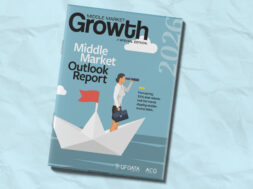How Manufacturers (and Dealmakers) Are Managing Cyber Risks
At ACG Chicago’s 2024 Manufacturing Symposium, panelists discussed heightened cybersecurity risks and the opportunities for automation amid labor challenges

In 2023, manufacturing was the industry most attacked by cyber criminals for the third year in a row, according to IBM’s 2024 X-Force Threat Intelligence Index report, with more than one-in-four attacks on the top ten industries targeting the sector.
At ACG Chicago’s 2024 Manufacturing Symposium, held on Mar. 6, cybersecurity risk mitigation was top of mind, with panelists emphasizing that everyone within an organization must buy into the responsibility of managing cyber threats.
Continuing labor challenges and the forward march of automation were other major themes that emerged in the day’s conversations. Overall, a feeling of optimism for dealmaking in the year ahead pervaded the discussions as expectations for M&A in the sector in the coming year were overwhelming positive.
Cybersecurity Concerns Run High
ACG Event Recap
WHAT: ACG Chicago’s 2024 Manufacturing Symposium
WHERE:One North State, Chicago, IL
WHEN:Mar. 6, 2024
THE TAKEAWAY: With cyber criminals targeting the manufacturing sector, industry leaders are employing strategies to prevent fraud and protect value.
Cyber attackers have become much more organized and ruthless in recent years, said Latoya Conners Gray, North American director of credit and fraud at industrial supply company W.W. Grainger. “They are consummate business professionals just like you—it’s no longer someone sitting in a garage with a computer threatening someone,” she said.
Because of the increasingly sophisticated nature of these attacks, processes and protocols to mitigate the associated risks are essential. However, these processes can slow down operations and sales and may be especially challenging for customer-centric organizations. “The truth of the matter is you probably can go faster by not following processes,” Conners Gray said. “But the end result is what matters, because if you have to…call [a client] and have that hard conversation, if you have to do a report out to controllership on the dollar amount of error in a year, those are the things where process really helps.”
Fraud risks often arise during the due diligence phase of a deal, with the pressure to move quickly can create openings for bad actors. Conners Gray urged dealmakers to take a close look at the individual people in any company they’re acquiring to ensure that essential institutional knowledge isn’t being pushed out the door. “We’ve all been part of team where there’s [that one person] who knows everything about the company, every skeleton in the closet, every system ID and password is threaded through this one single person,” she noted, adding that dealmakers must be “really careful” about retaining that knowledge post-acquisition.
As data and its attendant insights become more important to businesses, data management was singled out as another area where cyber risks could rear their heads. “Data is like uranium: It can lead to a lot of trouble if not properly managed,” said Sri Manda, chief security and trust officer at Peloton Interactive. He advised that companies should carefully review regulatory and compliance requirements by country and state, and ensure that they’re incorporating the necessary controls into their digital journeys.
Coping with Labor Shortages
Labor shortages were another challenge facing the industry, with one commenter noting it is “nearly impossible” to find skilled workers to fill manufacturing roles. Panelists noted that they are turning to both workforce development and automation to address these issues.
“If we can get a machine to run unattended 16 out of the 24 hours a day, that’s a huge win,” said Jim Carr, president and CEO of CARR Machine and Tool. “This is a paradigm shift in our industry, much like it was in the ‘80s when CNC machinery was introduced to the manufacturing industry.”
Attracting and educating potential workers is another strategy businesses should consider, with apprenticeship programs and collaborations with tech schools and universities suggested as potential ways to do so. David Doyle, president and CEO of manufacturer Heidenhain Corporation, announced that his company was opening a manufacturing innovation hub in Silicon Valley to advance collaboration around technology and expand their involvement in workplace development.
“What we do know is that manufacturing right now is a high-tech, high-paying, great career you can have for the rest of your life and support a family,” said Carr. “I think we need to go to high schools and counselors and try to market it to young people now.”
A Sunny Outlook for M&A
Panelists shared positivity about the dealmaking year ahead without the qualifiers that have recently diminished forecasts for other sectors. Duncan Bourne, the managing director of middle-market private equity firm Wynnchurch Capital, pointed to a stabilizing interest rate environment as one of the major drivers for robust M&A activity within manufacturing.
“In the first couple of months [of 2024], have we seen an uptick in activity? Absolutely,” he said. “I think it’s because lenders, especially private lenders…know that the Fed said, we’re not going to raise interest rates anymore…and now they can plan ahead.”
Looking ahead to 2024 and 2025, there are also signs that the M&A market could see activity from family-owned manufacturing businesses that are looking for new leadership or a capital infusion. “There are a lot of companies out there that are second or third generation that may not have the interest (in the company) or access to the capital to do what it takes to advance and keep up with what’s going on, so that drives some decision-making, that drives conversations,” said Trent McFarland, M&A general manager with metals supplier Ryerson. “I think we’re going to continue to see that as manufacturing advances.”
Hilary Collins is ACG’s Associate Editor.
Middle Market Growth is produced by the Association for Corporate Growth. To learn more about the organization and how to become a member, visit www.acg.org.


